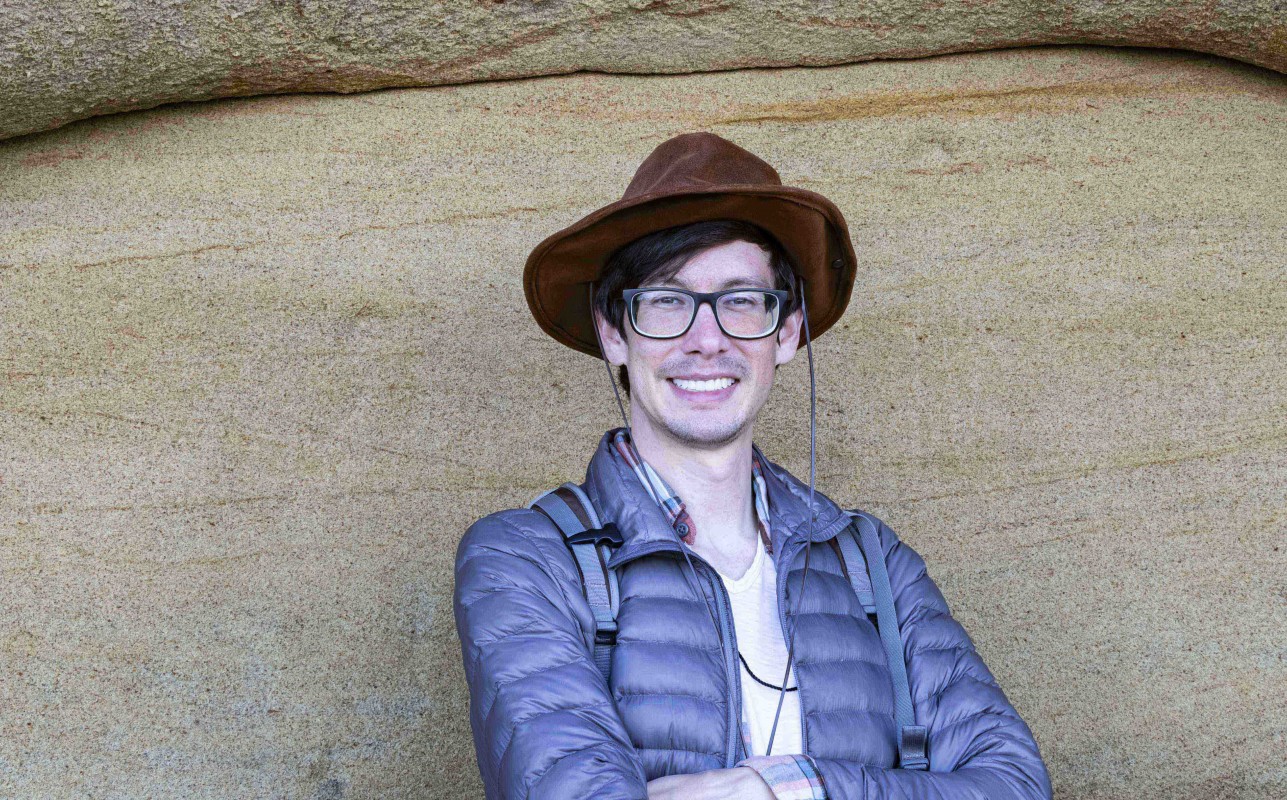Reading the earth: Doctoral student focuses on geostatistics

Think of geology as a book. What you see when you open your eyes is the cover — perhaps the deeply fissured Black Hills of Tyler Rust’s South Dakota childhood.
Underneath the surface, layers of soil and stone comprise the pages. Elements are the smallest component: the letters spelling words, stringing together meaning in their relationships with one another.
For much of history, the meaning of those words and sentences seemed elusive, even mysterious. That’s where geostatisticians such as Rust come in: using technologies such as x-ray fluorescence and computer algorithms to discover new ways to interpret data and piece together the underlying meanings.
“It’s Mother Earth’s autobiography, but we were never able to translate it; we didn’t know the language,” explained Rust, a fourth-year doctoral student in Binghamton University’s geological sciences program. “We can finally interpret some of this, reading these layers like the pages of a book.”
Unmixing the cake
Rust developed his interest in nature and what lay beneath its surface early in life; he grew up near Mount Rushmore, an area known for its geologic complexity.
“I was always an endlessly curious individual and obsessively compelled to learn everything about everything — to remember every rock, every plant and every animal,” he reflected.
While attending the South Dakota School of Mines & Technology, an engineering college, he began working on research projects related to the Pine Ridge Indian reservation, particularly issues related to contamination from the heavy metals uranium and arsenic. That sparked an interest in the niche field of medical geology, which studies the relationship between human health and geological formations. Thanks to the Benjamin A. Gilman International Scholarship, Rust studied medical geology at Turkey’s Istanbul Technical University for eight months.
When he began searching for graduate school opportunities, Rust became interested in Binghamton after he learned that faculty members were working in areas pertinent to his interests. Once he arrived, he realized that researchers need to employ computers and advanced algorithms to apply the right kinds of equations to the data sets used in medical geology and similar pursuits — and he decided to fill that gap.
“There’s a big struggle with science. Learning new things is challenging, but communicating them is much more so,” he explained. “The reality we’re in is complex and we seek to understand that.”
Geological research often involves a core — a long skinny tube of material extracted from the ground — which is then scanned inch by inch with handheld devices to learn the concentration of each element. With 30 elements at each data point, the scan produces an extremely large data matrix, which is then run through a computer algorithm that looks for the relationships between the elements.
“So, from 29 elements you can go to three to seven groupings and the output can be interpreted,” Rust said. “My job as a geostatistician is to tell you what this grouping means. We use an analogy: It’s like unmixing a cake.”
It’s an apt metaphor, especially when you consider that Rust is testing his methodologies on mud rocks. You can think of sedimentary basins as a mixing bowl, he explained. Streams bring in rocks, and microscopic particles from the air also settle. Creatures live then die, mixing their skeletons or shells into the earth. Through time, all these ingredients mix together, sink down and are subjected to heat.
This process creates mud rock, which make up 60 percent of the entire sedimentary record on earth; varieties include slate and shale, common in the Southern Tier. The human eye can’t see the ingredients of mud rock — which is composed of particles that are only a thousandth of a centimeter — any more than it can pinpoint the eggs, flour and butter used in a sheet cake.
Rust uses his methods of analysis on all of the data the department has extracted in-house, without reading any of the prior results first. He then compares his interpretation to previous interpretations. So far, they’ve all matched up, he said.
One of the statistical tools Tyler will use in the future is positive matrix factorization, which was developed by the Environmental Protection Agency for use on aerosol data sets, explained Professor Joseph Graney, who previously used PMF while working with the agency on a project in the Alberta oil sands region. “That work inspired us to task Tyler with developing ways to use PMF on geological datasets, which is a unique and untested opportunity for application of the PMF technique,” he said.
Long-term, Rust plans to become a professor himself, although he’s open to other opportunities, such as consulting and policy-based work. His guides along the way include Associate Professor Jeffrey Pietras and Graney, who have helped him become a better scientist and develop as an academic.
“I didn’t want to get a PhD; I wanted to be a PhD,” he said. “It’s a process of becoming a particular type of individual that could teach science as a way of thinking, to teach people not what to think but how to think.”
According to Pietras, Rust is well on his way to becoming just that. He’s a true scientist, and deeply cares about understanding the unknown, Pietras said.
In fact, Rust commonly brings “oddball” rocks to department social gatherings for all to examine and guess their identity. Frequently, those guesses are proved wrong once the rock is analyzed on the department’s instruments. One time, be brought in a bottle of white sand from his mother’s hot water heater that looked a bit like kosher salt. Pietras guessed calcium carbonate, but it turned out to be pure zinc oxide, leading to lengthy discussions about potential sources.
“He likely doesn’t realize it, but those exercises have made us all better scientists,” Pietras said.
